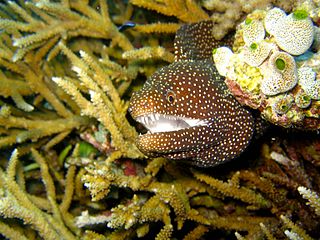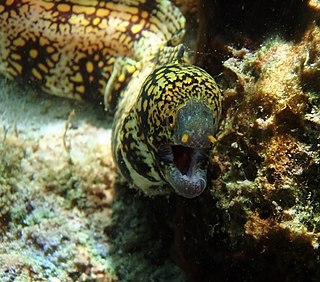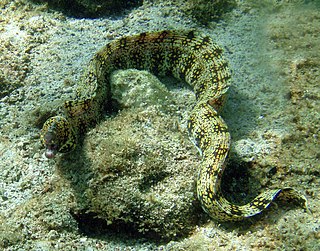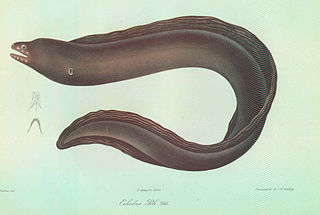Echidnas are Australian egg-laying mammals also known as spiny anteaters.

Moray eels, or Muraenidae, are a family of eels whose members are found worldwide. There are approximately 200 species in 15 genera which are almost exclusively marine, but several species are regularly seen in brackish water, and a few are found in fresh water.
In biology, a homonym is a name for a taxon that is identical in spelling to another such name, that belongs to a different taxon.
Mottled moray may refer to three species of eels:

Echidna is a genus of moray eels in the family Muraenidae.

The zebra moray is a species of marine fish in the family Muraenidae. It is the only member of the genus Gymnomuraena, though it sometimes has been included in Echidna instead.

The barred moray, also known as the banded moray, the dark-banded eel, the girdled moray, the girdled reef eel, the many banded moray eel, the ringed moray, the ringed reef moray, the striped moray and the zebra eel,) is a moray eel of the family Muraenidae. It was described by John Richardson in 1845, originally under the genus Muraena. It is a marine, tropical eel which is known from the Indo-Pacific, including the Red Sea, East Africa, the Hawaiian Islands, the Marquesan Islands, the Tuamotus Islands, the Ryukyu Islands, and the Great Barrier Reef. It dwells at a depth range of 2 to 20 metres, and leads a benthic lifestyle in reefs and shallow lagoons. Males can reach a maximum total length of 72.3 centimetres (28.5 in).

The snowflake moray, also known as the clouded moray among many vernacular names, is a species of marine eel of the family Muraenidae. It has blunt teeth ideal for its diet of crustaceans, a trait it shares with the zebra moray.
Nebulous is a post-apocalyptic science fiction comedy radio show.

Echidna catenata, commonly known as the chain moray, is a moray eel found in shallow parts of the western Atlantic Ocean and from islands elsewhere in the Atlantic. It occasionally makes its way into the aquarium trade. It grows to a maximum length of 165 cm (65 in) but a more common length is about 40 cm (16 in).

Eels are ray-finned fish belonging to the order Anguilliformes, which consists of eight suborders, 20 families, 164 genera, and about 1000 species. Eels undergo considerable development from the early larval stage to the eventual adult stage and are usually predators.
In zoology, the principle of homonymy is one of the guiding principles of the International Code of Zoological Nomenclature.

Echidna amblyodon, the Sulawesi moray is a moray eel found in the western central Pacific Ocean. It was described by Bleeker in 1856, originally under the genus Muraena. It is a marine, tropical eel which is known from Indonesia, in the western central Pacific Ocean. Males can reach a maximum total length of 20.5 centimetres (8.1 in).

Echidna delicatula, the mottled moray, also known as the fine-speckled moray, is a moray eel. It was described by Johann Jakob Kaup in 1856, originally under the genus Poecilophis. It is a marine, tropical eel which is known from the Indo-Pacific, including Sri Lanka, Samoa, and Japan. It inhabits coral reefs. It can reach a maximum total length of 65 centimetres (26 in).
Echidna leucotaenia, the whiteface moray, also known as the white-banded moray eel, is a moray eel. It was described by Schultz in 1943. It is a tropical, marine and freshwater eel which is known from the Indo-Pacific, including East Africa, the Line Islands, the Tuamotu Islands, and Johnston Island. It dwells at a depth range of 0 to 24 metres, and leads a benthic lifestyle in reefs. Males can reach a maximum total length of 75 centimetres (30 in).

Echidna nocturna is a moray eel found in the eastern Pacific Ocean, in the Gulf of California and around Peru and the Galapagos Islands. It was first named by Cope in 1872, and is commonly known as the freckled moray or the palenose moray. It was discovered that Echidna nocturna and Muraena acutis are the same species.

Echidna peli is a moray eel found in the eastern Atlantic Ocean. It was first named by Johann Jakob Kaup in 1856, and is commonly known as the pebbletooth moray.
Echidna rhodochilus is a moray eel found in the Pacific and Indian oceans, around India and the Philippines. It was first named by Bleeker in 1863, and is commonly known as the pink-lipped moray eel.
Echidna unicolor is a moray eel found in coral reefs in the Pacific and Indian Oceans. It was first named by Schultz in 1953, and is commonly known as the unicolor moray or the pale moray. It is usually completely tan or light brown in color, aside from a dark ring around each eye.
Banded moray is a common name for several fishes and may refer to:










